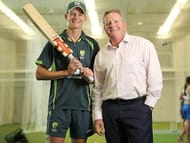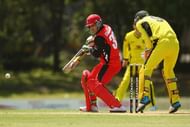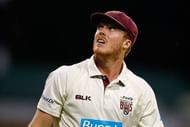Much like other sports, cricket has witnessed its fair share of dynasties – the Hearnes, the Headleys, the Mohammads, the Hadlees, Khans and Bracewells - all of whom boast of at least 3 players who have donned the national cap in Test cricket. Recent sensations include the sons of Geoff Marsh and that of Roger Binny.
While Mitchell has already sealed his spot in the national team and Shaun has been in the reckoning for quite some time now, Stuart Binny has already had his bite at the coveted apple and has been in and out of the team courtesy his inconsistent performances.
In this article, I focus on the young juniors of great cricketers who look set to follow their fathers’ footsteps and make it as big as their previous generations did.
1. Tagenarine Chanderpaul
The single unique feature that sets aside Shivnarine Chanderpaul from all those who have graced the willow in the history of the game is his idiosyncratic stance at the crease. While it is safe to say that West Indies’ most capped Test player and one of the latest entries into the 10.000 Test runs club has had his fair share of international cricket, it remains to be seen whether his son Tagenarine succeeds in continuing his legacy.
Although not the stance, there exist several traits of the senior Chanderpaul’s batting in that of his son Tagenarine’s. It’s not quite inconceivable, considering the fact that his initiation to the game began at the hands of grandfather Khemraj who persuaded the then six-year-old to undergo similar gruels as his father on the same concrete strip at the nets under the house which still bears the marks of Shivnarine’s training in the 1970s.
On the field, Tagenarine is a dogged left-hander, patient and persisting, firmly rooted to his crease without giving so much a hint of throwing away his wicket. He is barely 19, but his cricketing outlook consciously reminds one of the many qualities that helped his father hold the West Indies middle-order together for years after Brian Lara’s retirement.
His lean, tall frame is similar to that of his 20-year-old father debuting against England in 1994. The shyness in front of the camera speaks a word or two about his reticent genes. He debuted for Guyana at 16, only one year younger than what his father had been while playing his first regional match in 1992.
Turning up for Guyana against Trinidad & Tobago in March 2013, they became the only second West Indies father-son duo to play first-class cricket together. Months later, Shivnarine’s Derbyshire team went head to head against Stainsby Hall Cricket Club represented by Tagenarine.
Although not an established figure in the domestic circuit, the 19-year old southpaw has already impressed many with his exploits at the Under-19 World Cup in UAE last year. The unbeaten 84 against Zimbabwe remains the highlight of his career, not because it helped his team to a 167-run thrashing, but for the reason that it came off 135 balls spanning over three hours – a resemblance to Shivranarine’s brand that cannot be overlooked.
2. Tom Healy
The iconic name of Ian Healy is etched forever in golden letters in the annals of wicketkeeping history of the game. Not only had the Australian legend been the best glovesman of his time, but he has also served as an embodiment of traditional gloves work and an inspiration to countless cricketers taking up wicketkeeping.
Having played the last of his 119 Tests when his son was only three, Ian has now reserved himself to a family life which includes nurturing the talent of a promising cricketer in Tom Healy. Although awed by his father, Healy Jr. knows it’s up to him to create his mark in the sport, much like his cousin Alyssa who has been involved with the women’s international team for a number of years.
Deciding to follow his father’s path as a wicketkeeper, was invariably going to earn him comparisons and even at 18 years of age, the right-hander is not totally unaware of it. Cricket, however, had happened to the 18-year-old Brisbane boy by accident.
Always a handy golfer, Tom had found himself donning the gloves in junior school when they were rotating various roles. Countless hours of practice at the garage and in the backyard under the vigilant eyes of his father ensured that his technique improved by several folds.
Tom’s big break, however, was the call-up for Australia’s Under-19 tour of Sri Lanka last year, followed by the Under-19 ODI series against England this April. Surprisingly, three decades ago, it had been his father Ian Healy who had been a part of Australia’s Under-19 team in 1983 while working at Brisbane’s Greg Chappell Cricket Centre.
3. Tom Latham
1992 World Cup hero Rod Latham had a nickname – Rockin’ Rod. As a 15-season domestic cricket veteran who has represented his country in Test cricket on four occasions and played 33 ODIs, his fierce competitiveness is not unheard of in the streets of Canterbury. The reluctance of gunning for the selector’s spot, however, has got to do more with his sons following his footsteps than the diminishing fire in the belly.
Although both his sons Matt and Tom have been involved in cricket for some time, it has been the latter who has gone from strength to strength playing for Canterbury before achieving the ultimate goal of earning a national cap. To this day, he has featured in 26 ODIs and 10 T20s, and is gradually cementing his spot at the top of the order in Tests.
In November last year, after a string of half-centuries that he failed to convert into big scores, Tom finally got the monkey off his back with a splendid 103 on the third day of the Abu Dhabi Test against Pakistan, albeit in a losing cause. With a similar 137 in the next match at Dubai – his sixth Test overall – the wicketkeeper-batsman seemed to have sealed his spot for a number of Tests to come.
His figures continue to overshadow that of his fathers’ and the old man could not be happier about it. Not much has been evident about the 23-year-old’s technique and style so as to comment on his resemblance with his father, but it is of no doubt that he is firmly set on the latter’s footsteps having now made it into the record books for being the third father-son duo to score an international century for the Kiwis.
4. Jake Lehmann
Australian head coach Darren Lehmann has a bronze statue at Adelaide Oval. He has played 27 Tests for Australia and garnered most of his fame in the 117 times he has donned the prestigious Baggy Green in One Day Internationals. His all-time leading run scorer record in the 122-year-history of Sheffield Shield is looked at with veneration.
Bearing the surname of such a personality is hardly an uncomplicated job, and many would yield under the burden of it, 22-year-old Jake Lehmann, however, is built of a different material. While constantly aware of the endless comparisons with his father, he answers questions in the quintessential laconic manner of an Australian looking to carve out a niche for himself.
Jake is a left-handed batsman and a slow left-arm orthodox bowler like his father. But the similarities end right there. South Australian coach Darren Berry, who has observed both the generations closely, comments, “So far, I haven’t seen him smoke or drink and he’s got a slightly different body shape to his old man.”
Instead of following his father to the core, Jake is more interested in making a mark in the domestic circuit with his individuality. An exceptional season with the East Torrents in the grade competition and a couple of impressive performances in the pre-season matches for Redbacks earned him a rookie contract for South Australia last year.
The ultimate Baggy Green dream continues to inspire him, as does the credentials of his dad, but the realistic southpaw knows he has to make it count in State cricket before he gets an opportunity to strike gold in international platform. Two fifties in two first-class matches against formidable opponents like Victoria and Queensland may be just the beginning of a career Jake had been looking for.
5. Alister McDermott
Right-arm pacer Alister McDermott bears his father’s first name in his middle name. It’s as much a tradition in the McDermott family, as is earning cricket contracts during teenage years. Craig had debuted in Test cricket when he had been 19; his son signed a rookie contract with Queensland while still at high school.
Alister’s red hair and bowling action can be traced to his old man whose tally of 291 wickets at the highest level may appear to inspire his son. Surprisingly though, the right-hander admits not having distinct memories of his father’s career since the latter retired when he was barely four or five. Of course, he is familiar with his resemblance to McDermott Sr’s action, having watched broadcasts of classic matches on television.
After a reasonable season at the national under-17 championships, Alister impressed in the Under-19 World Cup in 2010 clinching 4 wickets for 29 runs in a Group B match against USA. A superb 2011-12 season where he emerged as the leading wicket-taker in Australia’s domestic one-day competition earned him a call-up for the ODI series against Pakistan in the UAE.
The national jersey continues to elude him in ODIs and Tests, but with 75 wickets in 20 first-class matches at an economy of 2.84, the Queensland bowler continues to make a strong case for himself. It only remains to be seen whether he can overshadow his father’s records once provided the opportunity at the big stage.
Looking for fast live cricket scores? Download CricRocket and get fast score updates, top-notch commentary in-depth match stats & much more! 🚀☄️




